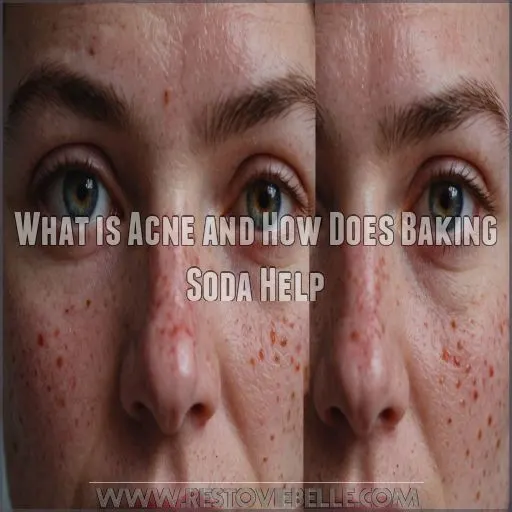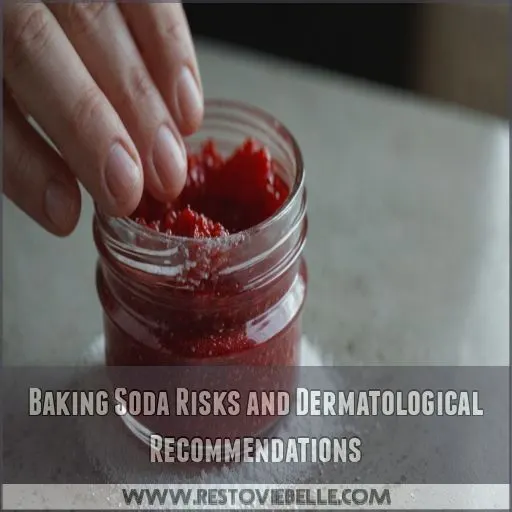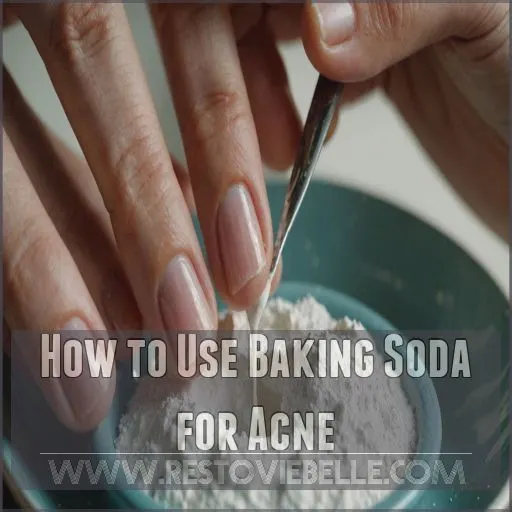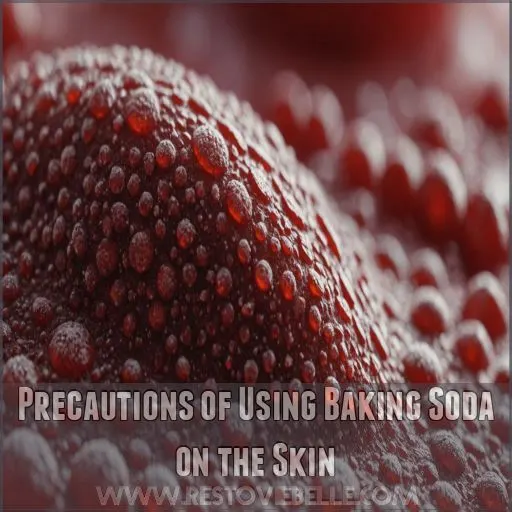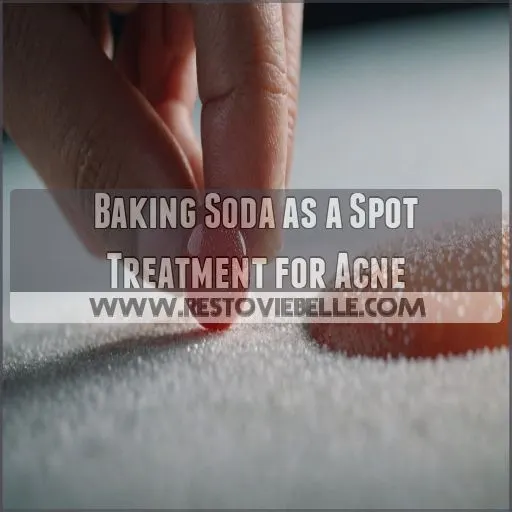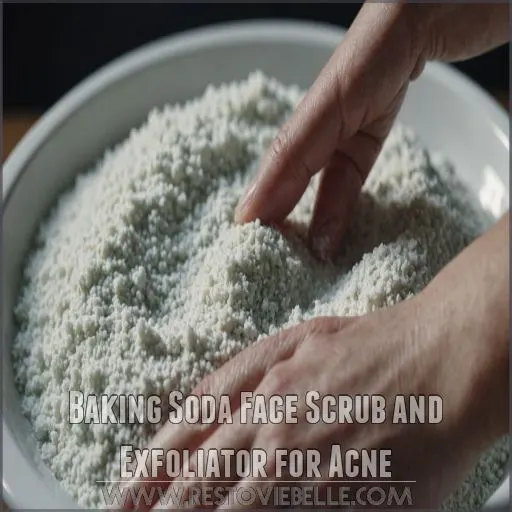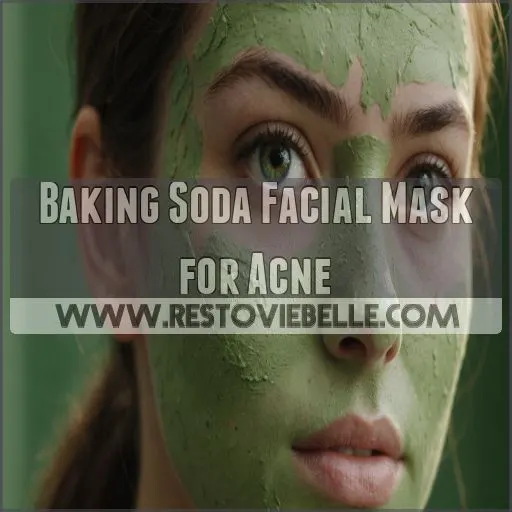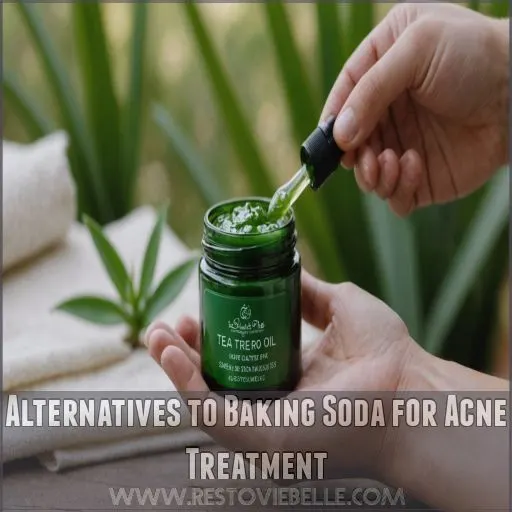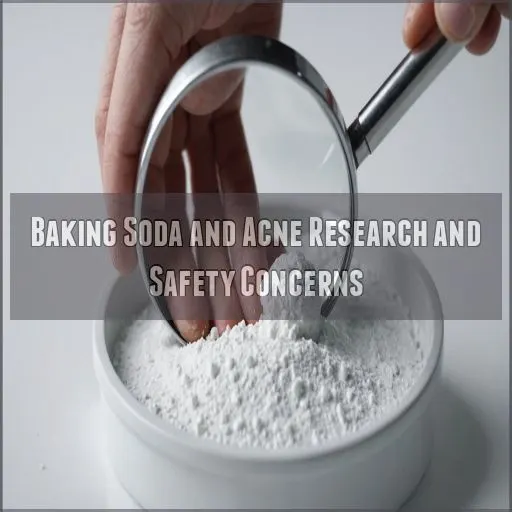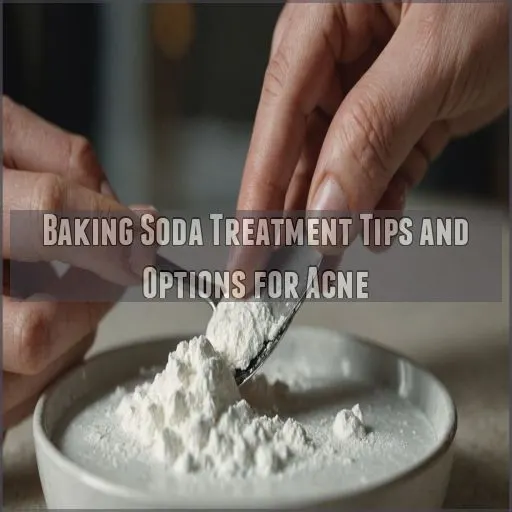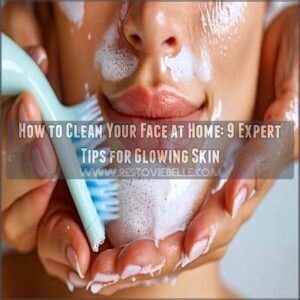This site is supported by our readers. We may earn a commission, at no cost to you, if you purchase through links.
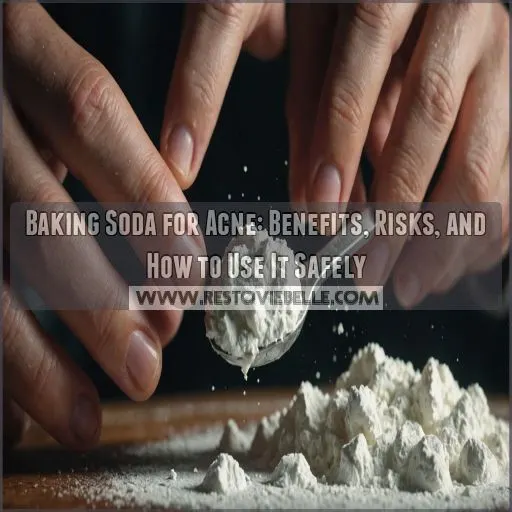 Thinking of using baking soda for acne? Well, tread carefully! While it’s an alkaline substance that might reduce redness and swelling, it can also throw your skin’s pH off balance, leaving it drier than a humorless joke.
Thinking of using baking soda for acne? Well, tread carefully! While it’s an alkaline substance that might reduce redness and swelling, it can also throw your skin’s pH off balance, leaving it drier than a humorless joke.
Many dermatologists suggest sticking to proven treatments instead. Spot treatments and face masks with baking soda can soothe temporarily, but moderation is key to avoiding skin irritation.
Remember, your face is not a science experiment, so handle with care! There are alternatives like tea tree oil that might keep your skin happier. Stay tuned for more insights into acne treatment options!
Table Of Contents
- Key Takeaways
- What is Acne and How Does Baking Soda Help
- Baking Soda Risks and Dermatological Recommendations
- How to Use Baking Soda for Acne
- Precautions of Using Baking Soda on the Skin
- Baking Soda as a Spot Treatment for Acne
- Baking Soda Face Scrub and Exfoliator for Acne
- Baking Soda Facial Mask for Acne
- Alternatives to Baking Soda for Acne Treatment
- Baking Soda and Acne Research and Safety Concerns
- Baking Soda Treatment Tips and Options for Acne
- Frequently Asked Questions (FAQs)
- Is baking soda good for pimples?
- Is it safe to use baking soda on your face?
- How to get rid of acne fast?
- How do you get rid of acne in 3 days naturally?
- Can baking soda reduce acne redness overnight?
- Is baking soda safe for sensitive skin types?
- How does baking soda affect acne scars?
- Can baking soda help with body acne?
- Are there long-term effects of using baking soda?
- Conclusion
Key Takeaways
- Don’t go overboard with baking soda for acne. It might feel like you’re a skincare scientist, but more than twice a week and your face could be as dry as the Sahara, leading to irritation and increased sensitivity.
- Be the pH hero your skin needs! Baking soda’s alkaline nature can disrupt your skin’s natural balance, leaving it as vulnerable as a toddler in a candy store. Always follow up with a moisturizer to keep dryness at bay.
- There’s not a ton of evidence backing baking soda as an acne warrior, despite its inflammation-soothing charm. Stick to proven treatments like tea tree oil or consult a dermatologist to avoid playing skincare roulette.
- For those pesky spots, baking soda might shrink pimples’ ego temporarily. Mix with water to make a quick paste, but keep in mind—it’s a temporary fix, not a miracle cure. Always rinse it off and stay hydrated with a good moisturizer.
What is Acne and How Does Baking Soda Help
Acne, those pesky bumps that seem to appear just as you’re getting ready for a big event, are often caused by clogged pores.
Baking soda might seem like an odd choice for acne, but its anti-inflammatory properties can help soothe inflamed skin, just like how a cool drink helps on a hot day.
Acne Causes and Symptoms
So, you’re dealing with acne? Whether it’s hormonal acne or diet-related, acne types range widely.
Here’s what typically causes breakouts:
- Excess oil production.
- Clogged pores.
- Bacteria.
- Inflammation.
Chest acne or skin infections can also occur.
Baking Soda Properties and Benefits for Acne
Baking soda can be a double-edged sword in your skin care arsenal.
It’s an alkaline substance often touted in DIY remedies for acne.
While it might exfoliate and tackle skin irritation, its disruption of pH balance demands cautious use.
How Baking Soda Reduces Acne Inflammation
Baking soda’s alkaline pH helps soothe angry, inflamed acne by neutralizing irritation. Its anti-inflammatory properties can:
- Calm redness and swelling
- Inhibit bacterial growth
- Promote healing
- Prevent future breakouts
Baking Soda Risks and Dermatological Recommendations
When considering baking soda for acne, you should know that it might cause more trouble than it’s worth.
Disrupting your skin’s pH is like letting a toddler loose in a candy store—it can quickly shift from a minor inconvenience to a sticky situation.
Potential Side Effects of Baking Soda for Acne
While baking soda might seem like a knight in shining armor for your acne woes.
Watch out for possible side effects like skin irritation, redness, dryness, inflammation, and sensitivity—especially with persistent use.
Disrupting Skin’s Natural PH Balance
Your skin’s pH balance isn’t something to toy with lightly.
Using baking soda can disrupt this acid mantle, leading to skin barrier damage.
Instead, consider aloe vera or a soothing face mask.
Stripping Natural Oils and Moisture
Baking soda can strip your skin’s natural oils, leaving it parched and vulnerable.
Dryness may worsen acne, so moisturize well after any baking soda treatments. Avoid over-washing, and choose gentle, hydrating products.
- Coconut oil soothes dry skin
- Tea tree oil fights acne
- Poison ivy, diaper rash, and mosquito bites – baking soda can help!
- Moisturize, moisturize, moisturize!
Limited Research on Baking Soda for Acne
Scientific evidence on baking soda’s acne-fighting prowess is as rare as hen’s teeth. Dermatological opinions echo safety concerns, questioning long-term effects. For clearer skin, explore proven alternatives under expert guidance.
How to Use Baking Soda for Acne
You can use baking soda for acne in different ways, like a face mask, exfoliant, or boosting your facial cleanser.
Just remember, your skin might not appreciate being mistaken for a baking sheet, so use it gently and follow up with your favorite moisturizer!
Baking Soda Face Mask or Exfoliant
When using baking soda for a DIY mask or exfoliant, be cautious of skin sensitivity. Mix with water and apply gently.
- Enjoy the exfoliation benefits
- Limit frequency
- Rinse thoroughly
- Moisturize after
- Don’t overdo it; moderation’s key
Boosting Facial Cleanser With Baking Soda
If you’re looking to give your daily cleanser a boost, try mixing in a small amount of baking soda.
This gentle exfoliant can help unclog pores and soothe skin irritation, just like using a sharp razor can reduce irritation and itching after shaving.
Just don’t overdo it!
Spot Treatment for Acne Bumps
You’ve boosted your cleanser; now create a baking soda paste for spot treatment.
It’s a bit like treating acne bumps with a superhero cape.
But mind these steps:
- Mix baking soda and water.
- Apply directly to blemishes.
- Rinse after 20 minutes.
Precautions of Using Baking Soda on the Skin
When you’re using baking soda for acne, it’s important to be careful to avoid skin dryness and irritation—it can strip away your natural oils like a clumsy kid knocking over a milk glass.
Always moisturize afterward to keep your skin from feeling like it’s been through the desert!
Limiting Use to Prevent Dryness and Sensitivity
Using baking soda on your skin? Don’t overdo it—no one wants a flaky face! Restrict its use to twice a week.
| Frequency | Impact on Skin Type | Alternatives | Importance |
|---|---|---|---|
| Twice a week | Limits dryness | Tea tree oil | Hydration is essential |
| More than twice | Increases sensitivity | Aloe vera | Moisturizer is key |
Twice a week use of baking soda limits dryness.
More than twice a week use increases sensitivity.
Moisturizing After Baking Soda Treatments
After using baking soda, replenish your skin’s moisture with a nourishing moisturizer.
This helps counteract any dryness and keeps your complexion healthy.
Don’t skip this important step – your skin will thank you!
Avoiding Irritation and Over-Exfoliation
Try gentle exfoliation, but don’t overdo it with baking soda frequency.
Think of your skin like a sensitive friend — treat it kindly.
To avoid irritation, intersperse baking soda use with moisturizing tips and explore natural alternatives for balance, like clarifying shampoos.
Baking Soda as a Spot Treatment for Acne
When you’ve got an unexpected breakout, using baking soda as a spot treatment might seem like a quick fix.
Spot Treatment might temporarily reduce blemish size, it might also leave your skin feeling like the Sahara Desert.
Creating a Baking Soda Paste for Acne
Crafting a baking soda paste for acne is a cinch.
Grab these ingredients:
- 2 teaspoons of baking soda
- A few drops of water
- Mix until smooth
- Apply gently
- Let dry, then rinse off
It’s like creating a skincare superhero!
Applying Baking Soda to Individual Blemishes
To apply baking soda as a spot treatment, mix it with just enough water to form a smooth paste.
Gently dab this onto individual blemishes, leaving it on for at least 20 minutes before rinsing.
Benefits of Targeted Baking Soda Treatment
Targeting acne with baking soda can ease inflammation and irritation. It’s like sending a tiny firefighter to each pimple.
Here are a few benefits of this spot treatment:
- Reduces pimple size
- Calms redness
- Soothes irritation
Baking Soda Face Scrub and Exfoliator for Acne
Using baking soda as a face scrub for acne might make you feel like a skincare scientist mixing concoctions in your bathroom lab, but proceed with caution.
This DIY scrub can gently exfoliate, yet overdoing it might leave your skin as irritated as a cat in a costume.
Mixing Baking Soda With Water for Exfoliation
Think you might need a gentle DIY exfoliator?
For baking soda exfoliation, blend one teaspoon of baking soda with water to a paste. It’s easy as pie.
Remember, your skin’s pH balance is important—don’t scrub too hard.
Consider alternate exfoliants, too!
Using Baking Soda as a Gentle Exfoliant
Gently exfoliating with baking soda can slough off dead skin cells, unclog pores, and leave your complexion feeling refreshed.
Just don’t overdo it – moderation is key for sensitive skin types, like those looking for a gentle cleanser.
Avoiding Over-Exfoliation With Baking Soda
Let’s face it, nobody wants skin scraped raw like over-sanded wood.
Here’s how to avoid over-exfoliation with baking soda:
- Limit to twice a week.
- Use gentle pressure.
- Add enough water.
- Consider alternative exfoliants, like oatmeal.
Baking Soda Facial Mask for Acne
For a simple skin-care hack, try making a facial mask with baking soda, lemon juice, and water to help tackle acne.
Just don’t leave it on long enough to turn into a Halloween mask—your face isn’t supposed to look frightening!
Combining Baking Soda With Lemon Juice and Water
Mix baking soda with lemon juice and water to make a DIY face mask. This combo packs exfoliating power but can increase skin sensitivity.
Watch out for the potential risks: skin irritation and dryness.
Always patch-test before diving in!
Benefits of a Baking Soda Face Mask for Acne
A baking soda face mask can work wonders for acne-prone skin, helping to control oil, exfoliate gently, and leave your complexion feeling refreshed.
Whip up this DIY treatment for a budget-friendly acne-fighting boost.
Applying and Removing the Face Mask
Slap on that baking soda mask with these steps:
- Consistency: Keep the mask thick, like peanut butter.
- Application: Spread evenly across your face.
- Drying time: Leave for 10-15 minutes.
- Mask removal: Rinse with lukewarm water.
Alternatives to Baking Soda for Acne Treatment
While baking soda might seem like a quick fix for acne, there are plenty of safer and dermatologist-approved alternatives.
From tried-and-true medical treatments to natural remedies like tea tree oil, you have options that won’t leave your skin feeling like the Sahara Desert, and if you’re dealing with beard bald spots, you can explore options like treating patchy beard growth.
Approved Medical Acne Treatments
With countless options out there, consider these approved medical acne treatments:
| Treatment | Benefits |
|---|---|
| Prescription meds | Targets severe acne |
| Topical treatments | Reduces bacteria |
| Oral antibiotics | Decreases inflammation |
| Retinoids | Prevents pore blockage |
Laser therapy can also zap acne woes!
Natural Remedies for Acne, Such as Tea Tree Oil
Tea tree oil’s antimicrobial punch and aloe vera’s soothing touch can provide natural acne relief. DIY masks with these ingredients may offer a gentler, more holistic approach to tackling breakouts.
Consulting a Dermatologist for Acne Treatment
Don’t go down the rabbit hole of DIY treatments without checking professional advice.
Dermatologists offer a goldmine of acne treatment options perfectly suited to you.
Use a dermatologist finder tool to get expert recommendations.
It’ll save you time and skin trouble!
Baking Soda and Acne Research and Safety Concerns
Using baking soda for acne might seem like a quick fix, but it’s important to know the safety concerns and research involved.
It’s not just about slapping on a paste and hoping for the best—your skin deserves a little more care, especially given baking soda’s potential side effects.
Safety Concerns and Potential Side Effects
Exploring alternatives for acne, you’ll find baking soda’s appeal. However, exercise caution due to potential skin irritation.
Too much can upset your skin’s pH balance like a bull in a china shop—causing dryness and sensitivity.
It’s like using a sledgehammer to crack a nut; sometimes, less is more for maintaining skin’s natural harmony.
Importance of Using Baking Soda With Caution
While baking soda may seem like a quick fix, it’s important to use it with caution.
Its alkaline nature can disrupt your skin’s delicate pH balance, leading to dryness, irritation, and even worsening acne.
Moderation is key – stick to no more than twice a week to avoid long-term damage.
Baking Soda Treatment Tips and Options for Acne
Looking to tackle your acne with baking soda?
Let’s explore simple tips to make the most of this kitchen staple.
While avoiding a dry and flaky skin disaster that even your ex wouldn’t recognize.
Using Fresh Baking Soda for Skin Care
When using baking soda for skin care, ensuring freshness is like picking the ripest fruit. Fresh baking soda preserves:
- Natural oils without causing havoc
- The skin’s pH balance, minimizing safety risks
- Effectiveness for your DIY recipes
Incorporating this little gem can make a difference—just remember not to leave it hanging around forever.
Avoiding Scrubbing and Excessive Dryness
When using baking soda for gentle exfoliation, easy does it.
Your skin’s like a delicate flower, so avoid scrubbing to prevent irritation, which is especially important when using a quality electric shaver.
Embrace your moisturizer routine like a hug for your skin, maintaining skin hydration.
Massage it with sensitive skin in mind.
Remember, too much enthusiasm can lead to excessive dryness, which nobody wants!
Frequently Asked Questions (FAQs)
Is baking soda good for pimples?
Think of your skin as a delicate chemistry experiment.
Baking soda can seem like a magic ingredient, but it’s a risky player.
Its potential for irritation and disrupting skin’s balance often outweighs any short-lived benefits for pimples.
Is it safe to use baking soda on your face?
Using baking soda on your face isn’t the best idea – it can disrupt your skin’s natural pH and lead to dryness, irritation, and even more breakouts.
Dermatologist-approved acne treatments are gentler and more effective.
Stick to them for safer, more effective results.
How to get rid of acne fast?
To zap acne fast, stick to proven treatments like benzoyl peroxide or salicylic acid.
They’re your skin’s knights in shining armor.
For severe breakouts, consulting a dermatologist is a smart move.
Keep calm and spot treat on!
How do you get rid of acne in 3 days naturally?
Want clearer skin in 3 days without harsh chemicals?
Gently wash with a mild cleanser, try tea tree oil or aloe vera as a spot treatment, and relax with a cooling honey mask.
Stay hydrated!
Can baking soda reduce acne redness overnight?
Like a Band-Aid on a scrape, baking soda might soothe acne redness overnight.
However, it could also disrupt your skin’s pH and cause irritation.
Always test gently and moisturize to avoid dryness or discomfort.
Is baking soda safe for sensitive skin types?
Baking soda can be harsh on sensitive skin, potentially causing dryness, irritation, and disrupting the skin’s natural pH balance.
It’s generally not recommended for those with sensitive types.
Stick to gentler, dermatologist-approved acne treatments instead.
How does baking soda affect acne scars?
Think of baking soda like sandpaper on soft silk—it can’t smooth out acne scars effectively.
It might irritate your skin or strip its natural oils, leaving it more fragile than before.
So, tread carefully.
Can baking soda help with body acne?
Using baking soda for body acne might feel like a quick fix, but beware—it can disrupt your skin’s balance like a bull in a china shop.
Dermatologist-recommended treatments make for a smoother, safer skincare journey.
Are there long-term effects of using baking soda?
Think using baking soda on your skin is harmless? Well, it can strip natural oils, leaving skin drier than a desert.
The disrupted pH balance might invite bacteria, leading to long-term irritation and sensitivity.
Consider alternatives!
Conclusion
Ultimately, while baking soda may offer a quick fix for acne, it’s important to tread carefully.
Moderation is key – overusing this alkaline substance can disrupt your skin’s delicate pH balance, leading to dryness and irritation.
Instead, consider gentler, proven remedies like tea tree oil or consulting a dermatologist for personalized acne treatment.
Your complexion deserves a thoughtful, long-term approach, not an experimental baking soda free-for-all.

